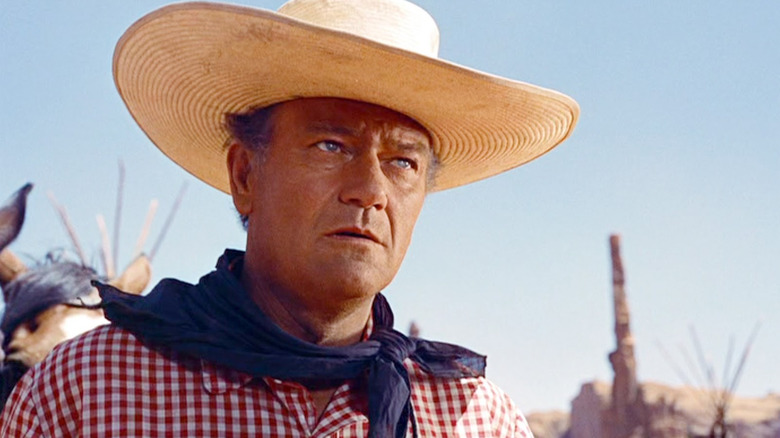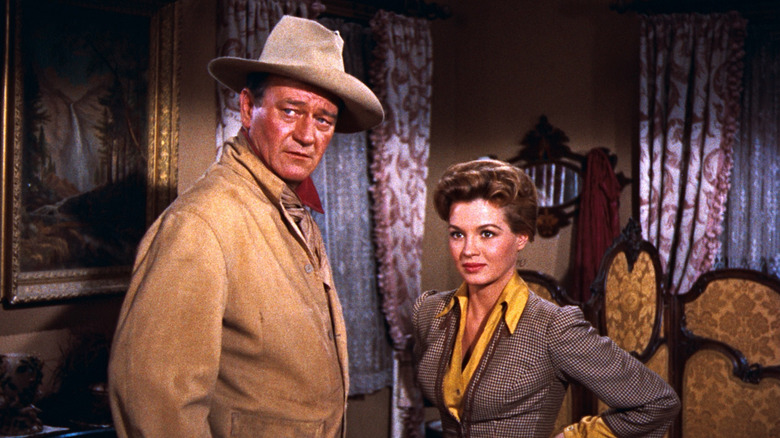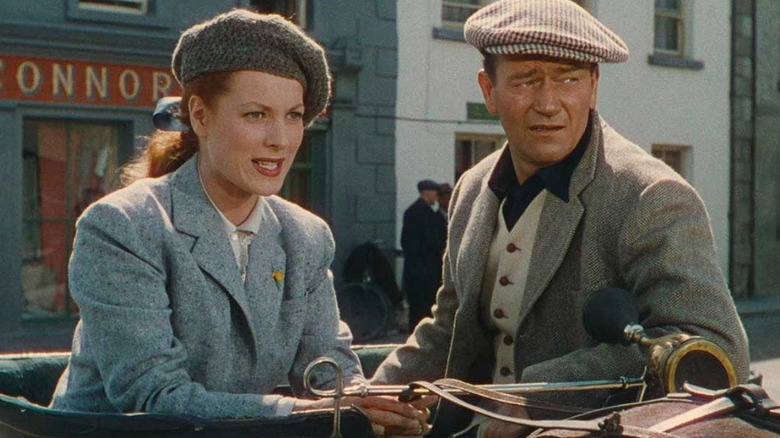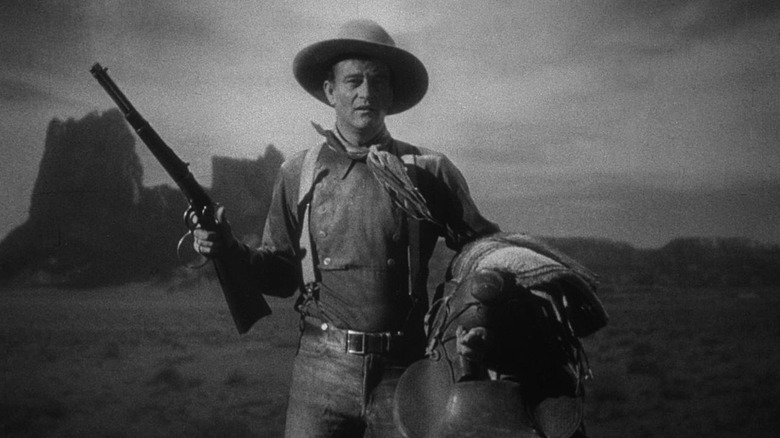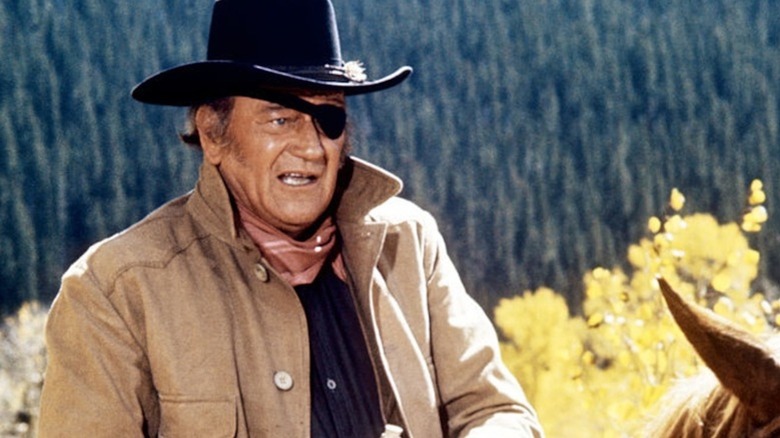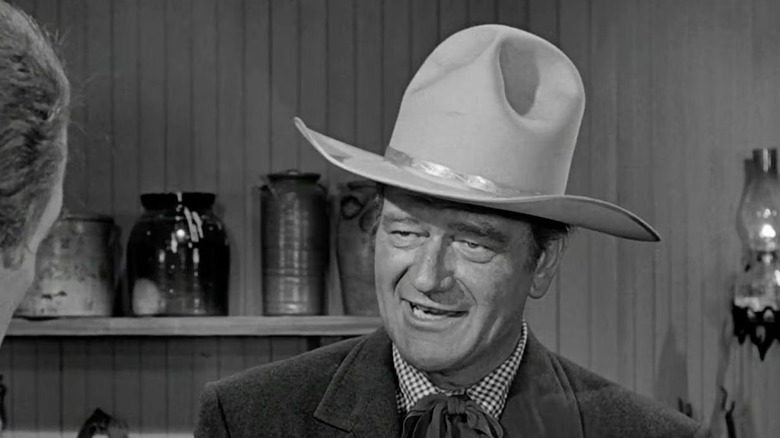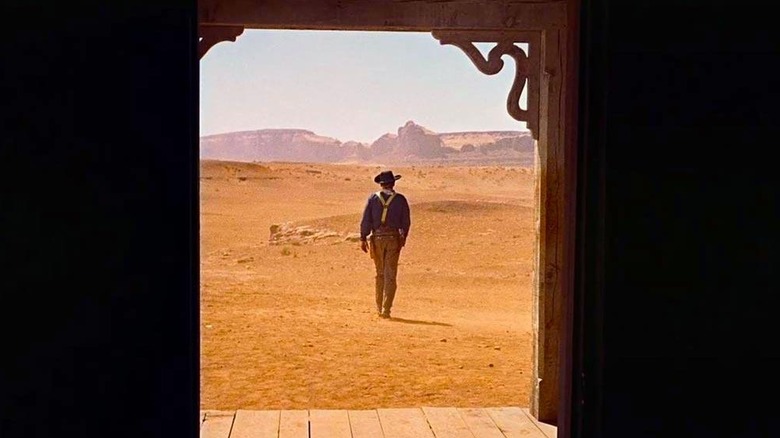6 Essential John Wayne Movies That Everyone Should See At Least Once
For better or worse, John Wayne, also known as The Duke, became a cinematic symbol of the jingoistic ideals of the American West: rugged individualism, Manifest Destiny, and hypermasculine law and order. With over 100 films to his name and a career that spans five decades, these six films you should see at least once because they not only represent the sheer enormity of John Wayne's star power and why he has become synonymous with the Western genre, but are also foundational works of film history. John Wayne's career is a compelling way to observe the early days of Hollywood under the studio system, a pivotal period in cinema that has inspired generations of future directors.
John Wayne's staunch conservative politics were often questionable. He was a fervent supporter of the House Un-American Activities Committee (HUAC), the infamous witch hunt of leftist artists. In 1968, he released "The Green Berets," a propaganda film that aimed to rally Americans into supporting the Vietnam War. This made him painfully disconnected from the growing countercultural movement. Nevertheless, John Wayne remains an enduring cinematic icon, and probably the first person you think of (besides Clint Eastwood, who /Film crowned as the best Western actor of all time) when you think of a movie cowboy. The list below has John Wayne movies that should be on everyone's watch list.
Rio Bravo
Known for being one of Quentin Tarantino's favorite movies, Howard Hawks' "Rio Bravo" features John Wayne in one of his most charismatic roles. The movie was so successful that it launched an unofficial trilogy. It was enjoyable seeing John Wayne playing a character who was more than just the strong, silent type. His small-town sheriff, John T. Chance, gathers an unlikely group — a man with a disability, a drunk, and a young gunslinger — to help hold the brother of a local menace in jail.
"Rio Bravo" is an ensemble piece that features the stellar cast of Dean Martin, Ricky Nelson, Angie Dickinson, and Walter Brennan. We find ourselves enamored with watching this lovable troupe of underdogs even for the lengthy 141-minute runtime. Despite their great age difference, the Sheriff and Feathers share a warm, quick-talking rapport typical of a Hawksian film.
"Rio Bravo" was also made as a response to "High Noon," which John Wayne despised for depicting even the most devout of Americans not rising up to stand against a dangerous killer. In "Rio Bravo," everyone comes together to defend against lawlessness. Watching John Wayne's filmography, you will see filmmakers who defined cinema in the early twentieth century, and Howard Hawks is one of the most important figures. He creates a film that flows with ease, deftly interweaving exhilarating action and comedic hijinks.
The Quiet Man
"The Quiet Man" marks another partnership with John Ford, but in an entirely different genre than a Western: a romantic comedy. John Wayne plays Sean Thornton, an American man who travels to the small Irish village where he was born and falls in love with a stunning redhead played by Maureen O'Hara. They have a sparkling chemistry amidst the breezy plot of unpaid dowries and long, drawn-out donnybrooks.
John Ford is a master of capturing stunning landscapes, and the rolling hills of the Emerald Isle are something out of a storybook in this film. The quaint charm of the small town in Ireland is rounded out with quirky supporting characters such as a lively matchmaker, a well-respected widow, and many stereotypical hot-heads or pub regulars.
The love of Ireland from both John Ford and John Wayne, who have ancestral roots there, clearly shines through. The film's portrayal of Irish culture — its music, language, and heartfelt customs — is beguiling. This piece of sweet, fluffy nostalgia is also one of /Film's picks for best movies for St. Patrick's Day.
Stagecoach
John Wayne's earliest collaboration with John Ford transformed cinema and laid the groundwork for many modern action set pieces. His entrance with a dramatic dolly zoom as he twirls his gun and locks a steely gaze is a fittingly valiant moment; it announces the arrival of America's soon-to-be greatest screen hero with fanfare. John Wayne stars as Ringo Kid, a prison escapee vowing to avenge the murder of his father and brother, who comes across the traveling stagecoach making its dangerous journey through the American West, where danger from violent gunslingers and Apache warriors lurks around every corner. A ragtag group of passengers fills the stagecoach: a booze salesman, a corrupt financier, an intoxicated doctor, and a sex worker.
Director John Ford juxtaposes the tight, claustrophobic shots inside the tense stagecoach and its scrappy but frightened passengers with majestic vistas of Monument Valley. Rejecting the confines of Hollywood's artificial backdrops, Ford used the tangible, expansive desert to add a breathtaking grandeur to the film, making the stakes feel even more dramatic and real.
The desert serves as the vast stage for the legendary action set pieces, featuring John Wayne performing many of his own stunts, while Yakima Canutt famously pulls himself up from beneath the undercarriage of a galloping horse. There's no CGI or artificiality, just pure, practical filmmaking. These are real horses pounding the ground and carriages soaring through the air, making "Stagecoach" one of the most thrilling films ever made.
True Grit
John Wayne won the Academy Award for Best Actor for his role as the cantankerous Rooster Cogburn, a one-eyed U.S. Marshal hired by a young girl to hunt down her father's murderer. The bond he develops with Mattie Ross, played by Kim Darby, deepens despite their clashing personalities; she ends up smoothing out the rough outer edges of his brusque, hooch-loving nature. John Wayne considered Rooster Cogburn "his first decent role in 20 years." His bread and butter — the Western genre that reigned supreme during Hollywood's Golden Age—was starting to deteriorate, especially as daring filmmakers like Sergio Leone, Sam Peckinpah, and Arthur Penn were shattering traditional Western tropes.
Rooster and Mattie's unique relationship and sharp, witty banter shine. John Wayne's effortless portrayal of both the comedic and dramatic dimensions of a character who is inebriated half the time and a loyal protector the other is what makes "True Grit" one of his best films. The movie uses John Wayne's natural, commanding on-screen presence and legacy to inform the story in ways that his earlier work doesn't. "True Grit" forms the blueprint for the rest of John Wayne's career in more paternal roles, as if passing the baton to younger generations who will carry on the heritage of Western storytelling.
The Man Who Shot Liberty Valance
/Film writer Jack Hawkins praises this film as the best John Wayne movie of all time, even if he does have a smaller role. "The Man Who Shot Liberty Valance" was one of John Wayne's last collaborations with John Ford and pairs him with one of the popular stars at the time, Jimmy Stewart. Stewart plays a senator who returns to his small hometown and recalls killing a notorious outlaw.
One of the people he saves is Tom Doniphon, a rugged man who espouses, "Out here, a man settles his own problems," but the senator begins to question the ramifications of personal violence versus following the official rules of government bureaucracy. Released in 1962, "The Man Who Shot Liberty Valance" arrived at a time when movies were starting to poke holes in the Western mythology that John Wayne helped establish — a change that he did not welcome. This questioning of frontier machismo would increase during the late 1960s alongside the countercultural movement.
"The Man Who Shot Liberty Valance" is notably bleak and introspective, a tone reflected off-screen as well: John Ford made most people miserable on set due to numerous budget restrictions and lack of studio support, despite his reputation, since there was oater fatigue after the 1950s. The film's contemplation of the West's harshness and honor-bound values is poetic for Ford and Wayne's near-final collaboration. The stark black-and-white cinematography gives the entire film a funeral quality, fitting for a genre whose old traditions were dying before a radical transformation.
The Searchers
"The Searchers" is the definitive western. Here at /Film, we ranked it as the best western ever. John Wayne plays Ethan Edwards, a Civil War veteran whose home is destroyed and his niece taken during a Comanche raid. The isolated drifter spends five years searching for her, fueled by a burning hatred that becomes more volcanic when he discovers Debbie — now a young woman played by the luminous Natalie Wood — has willingly joined the Comanche tribe.
Ethan Edwards is not the typical swaggering hero that John Wayne is known for, but a lonely psychopath, dogged by an obsession and scarred by war. "The Searchers" also departs from the typical Western demonization of Native Americans; even though they can still be violent and ruthless characters, we get windows into their actions and motivations, shaped by the looming shadow of genocide that destroyed their community.
"The Searchers" has a visual grandeur that is unmatched. Director John Ford fills the frame with sweeping, elegiac shots of the vast desert stretching out as far as the eye can see. Every frame is a painting, one that has gone on to inspire many filmmakers, from George Lucas and Steven Spielberg to Martin Scorsese and Quentin Tarantino. The famous final image of Ethan in the doorway is a poetic and haunting encapsulation of what this beautiful film is about: Ethan is a lonely figure who has been unmoored by his own self-destructive behavior. The comforts of family and home are no longer a possibility for him.
